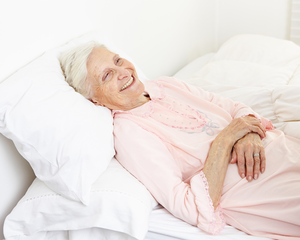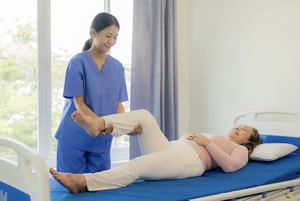At Access Rehabilitation Equipment, we commit to providing you and your loved ones solutions for life! Fitting your lifestyle, each aid and equipment is tailored to the unique challenges you are facing, so work with us to find the independence and mobility you want!

Bedsores, also known as pressure sores, can be a painful and debilitating condition for patients confined to a bed or chair for extended periods. These sores occur due to prolonged pressure on specific areas of the body, often over bony areas such as the shoulder blades, hips, tailbone, elbows, and heels. Not only do these sores cause pain and discomfort, but there’s also a risk of infection, and once established, they can be very difficult to treat.
Prevention is ultimately the best remedy. There is hope in preventing and reducing the risk of bedsores through proper care, positioning, supportive devices, and exercises. In this blog post, we’ll explore some helpful tips for preventing pressure injuries and motion exercises that carers can assist patients with to reduce the risk of bedsores.

How can pressure injuries be prevented?
Relieving pressure on the skin
The most crucial part in preventing and treating pressure injuries is relieving and distributing pressure effectively. Continuously applying pressure to a single area can restrict blood flow, causing damage to the cells and ultimately leading to sores.There are several ways to relieve and spread pressure, and a combination of these methods is typically the most effective approach.
- If you are confined to a bed, aim to change your position at least every two hours. For wheelchair users, consider changing position as frequently as every 15 minutes.
- Avoid sliding, slipping, slumping, and placing direct pressure on existing pressure injuries. Keep the head of a bed, recliner chair, or wheelchair elevated at a maximum of 30 degrees, as recliner chairs allow slipping. Recliner chairs should not be used as a substitute for a bed.
- Use mattresses, bed linens, and chair cushions specifically designed to relieve and spread pressure. Consult your healthcare provider to determine the most suitable products for your needs.
- Work with your doctor to ensure that there is no pressure on your skin or a good padding is in place to separate your skin from other surfaces.
Take care of your skin in general

Establishing a skincare routine is crucial for the prevention of pressure injuries. It helps maintain the skin’s protective function, supports proper circulation, and reduces the risk of tissue damage caused by pressure or friction. Here are some ways to effectively take care care of your skin and prevent pressure injuries:
- Bathe with a mild soap and warm water as often as needed to be clean and comfortable. Be careful not to scrub your skin too hard.
- Use moisturising creams or lotions to keep skin supple and prevent dryness, as damage is more likely to occur if the skin is too dry.
- If you have problems with bowel or control issues, learn to address incontinence, as skin becomes vulnerable with extended exposure to urine and stool. Clean your skin if it becomes soiled or wet, and apply a barrier cream or ointment to shield your skin from wetness. Use absorbent pads or briefs that keep moisture away from the skin.
- You may not be able to feel a bedsore developing, so ask your carer to perform daily checks particularly over bony areas, to look for early warning signs. Caregivers recommend putting pillows under these common areas and between parts of your body that press against each other, such as knees and ankles, if lying on your side. Consult your healthcare professionals if you come across red, purple, blue, torn, or swollen skin, cracks, calluses, and wrinkles, or signs of infection such as skin warmth.
Encourage a healthy lifestyle

A healthy lifestyle is also important in maintaining healthy skin and wound healing. Diet and lifestyle changes to avoid pressure sores include:
- Eat a balanced diet with enough fluids, calories, protein, vitamins, and minerals. If needed, consult your doctor about nutritional supplements like zinc and antioxidants. Maintaining a healthy diet will keep your skin healthy and able to heal quickly.
- Stay at a healthy weight, as having low body weight or being overweight can cause pressure sores. If you are at risk of malnutrition, your intake of proteins and fluids should be increased.
- Stay physically active as appropriate for your condition.
- Quit cigarette and tobacco smoking, as smoking can affect how the body heals and dries out the skin.
The best exercises for bedridden patients:

Even minimal exercise can help pressure wounds and prevent them from occurring in the first place. That’s because regular exercise improves blood circulation, strengthens your muscles, and improves your overall health. Before starting any exercise program, we recommend consulting your physician to put together a custom exercise plan suited to your needs and limitations.
Exercises for bedridden patients should be light and adapted to your specific needs. Without the need to stand up, you can perform the following exercises to improve your strength, range of motion, and decrease the risk of pressure injuries.
1. Ankle stretches
Performed to increase circulation and improve range of motion, caregivers hold the ankle and heel, slowly bending the food forward and upwards for several seconds. This is to be done when the patient is lying on their back.
2. Leg Lifts
Depending on the patient's strength, leg lifts a couple of times per day are effective by slowly bringing the leg up to the hip joint and holding for 10-20 seconds.
3. Palm Stretches
Patients begin by bringing their hand towards their body. Open the palm and extend fingers for a few seconds, then proceed by touching your thumb with each finger.
4. Finger Bends
Start by curling your fingers into a fist, then gently straighten them again, feeling a slight stretch. Repeat this exercise several times.
5. Wrist Rotation
Start rotating your wrist in circular movements. Do this ten times in a clockwise direction and ten times counterclockwise.
6. Arm lifts
Lift your arm as high as you can manage and try to hold for ten seconds. If lifting your whole arm is too difficult, try placing your upper arm on the bed and bending your elbow to bring your forearm to a 90 degree angle.
7. Arm Crosses
For this, extend your arms out to the sides until you feel a gentle stretch. Next, bring your arms closer together in a manner that they pass each other in a cross. This exercise helps a lot in preserving muscle function.
8. Hamstring Stretch
A caregiver may assist you with stretching exercises such as the hamstring stretch. While lying on your back with legs straight, the caregiver stands next to the bed. The caregiver lifts the leg closest to you off the bed and brings it toward your chest, keeping your knee straight. Hold for 20 to 30 seconds. This exercise is helpful as tight hamstrings make repositioning a patient difficult.
These routine exercises can be carried out with ease and can be beneficial if done regularly. The crucial thing to keep in mind is that consistency is the key! Try to complete at least five of these bedridden exercises each day.
Conclusion
Preventing pressure sores is key to maintaining a high level of care. Pressure sores can lead to reduced social interaction, pain and discomfort, which significantly impacts your quality of life. While these tips can help lower the risk of pressure injuries, it’s important to remember that everyone has different needs and circumstances that should be taken into consideration for proper care.
In addition to having an appropriate level of care plan in place, there are many products available to assist with your specific care and comfort needs. Contact one of our consultants who would be more than happy to discuss your needs with you.
FAQs
Can drinking water help with bed sores?
Yes, drinking water is crucial to maintaining good health and can help in the prevention and management of bed sores. Aim for a daily intake of at least 1.6 to 2 litres of fluids, equivalent to about 7 to 8 mugs or 11 to 14 cups. All types of liquids count, including tea, coffee, milk, water, juice, and alcoholic beverages with up to 4% alcohol content. So, make sure to drink plenty of fluids throughout the day to keep your body hydrated and healthy.
- priya says:Thanks for sharing such and informative blog on bedsore prevention.


 Providing solutions for life
Providing solutions for life







